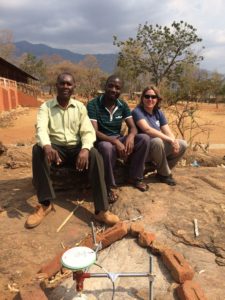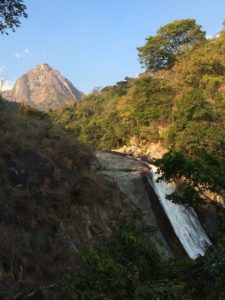By COMET Scientist Juliet Biggs
Malawi is a small country at the tip of the East African Rift. Small, that is, until you spend several weeks driving around in loops over challenging roads.
Ake Fagereng (Cardiff), Hassan Mdala (Geological Survey) and I covered nearly 5000 km in less than three weeks. Why would we do this to ourselves? To establish a baseline geodetic network at the southern tip of the East African Rift.
We want to know how strain is distributed, and which are the active structures. This latest field season is just another piece in the tectonic jigsaw that we hope will ultimately lead to improving earthquake resilience in developing countries.
Our partner for the last few years has been the Geological Survey Department of Malawi – in particular, Hassan, who operates a small mobile office in the back seat of the car. From here, he fixes all our problems, often before we even realize they exist; making use of a boundless network of friends and family, all of whom seem to be just waiting to help with our latest peculiar request.
Each GPS station is composed of an antenna, a receiver, a car battery, a regulator, a solar panel and a metal pin that we drill into the rock. Most of the kit only stays for 4 days, but we’ll need to re-measure the position of the pin for many years to come. In our search for suitable sites, we met many enthusiastic head teachers, police chiefs and district commissioners and one rather terrifying headmistress, all of whom helped with security arrangements in schools or telecommunications masts.

Everywhere we went, there were spectacular landscapes and interesting geology, most of which we were forced to drive straight past. But so much of my research is done from satellites orbiting at 600 km that I can get a bit over-excited about getting my nose to the rock again, and we took advantage of what opportunity we had.
Malawi is largely composed of various types of gneiss, a high-grade metamorphic rock, with lots of migmatites, blobs that were once partially molten rock. Perhaps the most spectacular landscapes are the ‘inselbergs’, large granite intrusions, which now stick several thousand metres above the surrounding landscape. On our only day off, squeezed somehow into a hectic schedule, we hiked up the largest of these, Mulanje, for some truly spectacular views. We also found some fascinating faults, but you’ll have to wait for the paper to hear about those!

Many people ask about the personal challenges to fieldwork in Africa, and there are indeed plenty of those: insect bites, the side-effects of malaria medication, power cuts, cold showers, endless meetings getting permission, long days driving over roads covered with pot-holes, goats, dogs, chickens and bicycles, and on this occasion a car break-in (I’m wondering if there’s such a thing as a frequent flyer card for local police stations…?).
But none of that matters much; I love every minute (well, almost, I could skip the police stations). A great trip requires great company: Hassan, for whom every minor disaster is ‘a learning opportunity’, and Ake whose response to the next challenge is usually ‘well, that’ll be fun’.

All I can say, is I learned a lot and had fun doing it, so I guess they are both right. I simply feel privileged to spend time in a country with such interesting scientific questions, beautiful landscapes and warm, friendly people. I suspect we’ll find a way to come back before too long!
Our fieldwork was funded by Global Challenges Research Fund through an EPSRC Institutional Sponsorship Award to the University of Bristol; a BGS-COMET fieldwork award and a Researcher Mobility Grant from the World Universities Network.
